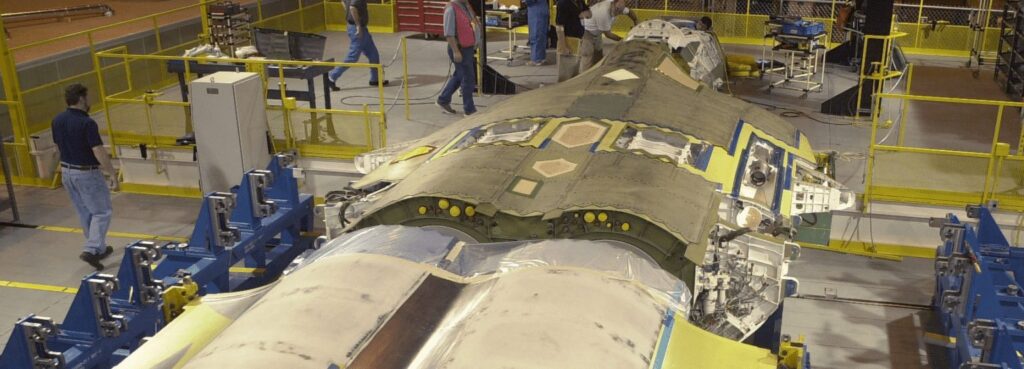Automation Advances: Using Machine Vision to Boost Aircraft Production
Automation Advances: Using Machine Vision to Boost Aircraft Production

The integration of state-of-the-art technologies is night cloaked deck revolutionizing the ever-changing aircraft production landscape. Automation, especially as it relates to machine vision, has become a key component in improving precision, efficiency, and overall quality in the manufacturing process. This article delves into the profound effects of automation, driven by machine vision, on aircraft production, elucidating the subtleties of how this technology is changing the way aircraft are designed and manufactured.
Introduction
The search for excellence has led to a paradigm shift in the automation space as machine vision, which enables machines to interpret visual data and make intelligent decisions, has been adopted. This article explores the various ways that automation, driven by machine vision, is not only optimizing workflows but also propelling the aircraft production sector to previously unheard-of levels.
Understanding Machine Vision in Aircraft Production
Defining Machine Vision:
Machine vision is a technology that enables machines to see, interpret, and respond to visual information. It encompasses a range of technologies, including cameras, sensors, and sophisticated algorithms, allowing machines to perform tasks that traditionally required human vision. In the context of aircraft production, machine vision plays a pivotal role in ensuring precision, accuracy, and efficiency throughout various stages of manufacturing.
Key Components of Machine Vision:
- Cameras:
- High-resolution cameras capture visual data, forming the foundation of machine vision systems.
- Different types of cameras, such as smart cameras and 3D cameras, serve specific purposes in aircraft production applications.
- Image Sensors:
- Image sensors convert light into electrical signals, facilitating the capture of visual information.
- Advanced sensors enhance the accuracy of data capture, which is crucial for precise manufacturing processes.
- Processing Units:
- Powerful processors analyze the captured data and execute complex algorithms.
- Real-time processing enables swift decision-making, a critical aspect in dynamic manufacturing environments.
- Software and Algorithms:
- Sophisticated software and algorithms interpret visual data, allowing machines to make decisions.
- These algorithms can be trained to recognize patterns, measure dimensions, and perform tasks essential for aircraft production.
The Evolution of Automation in Aircraft Production
Traditional Challenges:
- Manual Processes and Human Error:
- Manual processes were susceptible to human error, leading to variations and inconsistencies in aircraft components.
- Automation, driven by machine vision, minimizes human error, ensuring a higher level of consistency and precision.
- Time-Consuming Calibration:
- Traditional calibration processes were time-consuming, impacting overall production timelines.
- Automation with machine vision allows for real-time calibration adjustments, significantly reducing the time required for this crucial step.
- Limited Adaptability:
- Traditional manufacturing systems were often limited in their adaptability to design changes and variations.
- Machine vision, as part of automated systems, enables dynamic adaptations to changes in design specifications during production.
Advancements in Automation:
- Real-time Quality Control:
- Machine vision facilitates real-time quality control, identifying defects or variations in manufactured components.
- Automated systems can make instant adjustments, ensuring that only high-quality components proceed to the next stages of production.
- Dynamic Path Planning:
- Automation with machine vision allows for dynamic path planning for robotic arms and other automated systems.
- This ensures optimal movement and precision in tasks such as drilling, cutting, and assembly.
- Efficient Material Handling:
- Automated guided vehicles (AGVs) equipped with machine vision systems enhance material handling efficiency.
- These systems can navigate through the production floor, transporting materials and components with precision.
Applications of Machine Vision in Aircraft Production
1. Component Inspection:
- Machine vision systems inspect components for defects, ensuring that only flawless parts proceed in the production line.
2. Automated Assembly:
- Robotic arms equipped with machine vision capabilities facilitate automated assembly processes.
- Vision-guided robots can precisely position and assemble components with high accuracy.
3. Surface Inspection:
- Machine vision is used for surface inspection, identifying imperfections or irregularities that may affect aerodynamics or structural integrity.
Case Studies: Machine Vision in Action
1. Fuselage Assembly:
- Automated systems with machine vision streamline fuselage assembly processes.
- Robotic arms guided by machine vision ensure precise alignment and attachment of fuselage components.
2. Wing Geometry Verification:
- Machine-vision systems verify the geometry of aircraft wings during the manufacturing process.
- This ensures that wings meet the exact specifications required for optimal aerodynamics.
Future Trends and Industry Impact
1. Integration with Artificial Intelligence (AI):
- The integration of machine vision with AI is poised to bring about more advanced decision-making capabilities.
- This includes the ability to predict potential issues, optimize production workflows, and enhance overall efficiency.
2. Collaborative Robots (Cobots):
- The use of collaborative robots, or cobots, guided by machine vision is gaining prominence.
- These cobots can work alongside human operators, further increasing flexibility and adaptability in aircraft production.
Conclusion
Advancements in automation, powered by machine vision, are catalyzing a revolution in aircraft production. From ensuring real-time quality control to facilitating dynamic path planning and efficient material handling, the impact of automation is profound. As the industry continues to embrace these advancements, the future of aircraft production looks set to be characterized by unprecedented levels of precision, efficiency, and innovation.
FAQs – Frequently Asked Questions
- Q: How does machine vision contribute to real-time quality control in aircraft production?
- A: Machine vision systems inspect components in real-time, identifying defects and ensuring that only high-quality parts proceed in the production line.
- Q: What role does machine vision play in dynamic path planning for automated systems in aircraft production?
- A: Automation with machine vision allows for dynamic path planning, ensuring optimal movement and precision in tasks such as drilling, cutting, and assembly.
- Q: How is machine vision used in collaborative robots (cobots) in the aircraft production industry?
- A: Machine vision guides collaborative robots (cobots) to work alongside human operators, increasing flexibility and adaptability in aircraft production.
- Q: Can machine vision systems be employed for surface inspection in aircraft manufacturing?
- A: Yes, machine vision is commonly used for surface inspection, identifying imperfections or irregularities that may affect aerodynamics or structural integrity.
- Q: What are the future trends in the integration of machine vision with artificial intelligence (AI) in aircraft production?
- A: The future involves more advanced decision-making capabilities, including predicting potential issues, optimizing production workflows, and enhancing overall efficiency through AI integration.
Leave a reply
You must be logged in to post a comment.











